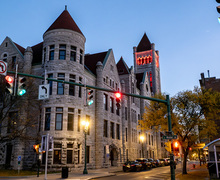18 days, 4 countries: Getting back to the US from China
Cassianne Cavallaro
The Daily Orange is a nonprofit newsroom that receives no funding from Syracuse University. Consider donating today to support our mission.
Editor’s Note: International Voice is a project that The Daily Orange’s Opinion section founded in partnership with WeMedia Lab, a student media organization at Syracuse University serving international students on campus.
As I sat on the carpet of my hotel suite in Phnom Penh, Cambodia, I worried about whether I could make it into the United States border before school started. Because of COVID-19, I had to travel around the world. I made it back to the U.S., but it was almost too easy.
As one of the few native Chinese students who went back to China in May and came back to the U.S. in August for the fall semester, I got to see my grandparents and finish my last year of college strong. I also got to see the differences between the two countries in combating the COVID-19 pandemic.
Looking back, the trip home to China was much more intense than my trip back to the U.S. I took off from the John F. Kennedy International Airport in New York City on May 9, transferred flights in Amsterdam and arrived in Guangzhou on May 10. Upon arrival, I was administered a COVID-19 test and spent 14 days in mandatory quarantine. On May 23, I finally got to go home to Beijing for another seven days of quarantine, and then I was finally free.
The whole trip was very intense, as everyone was covered head-to-toe in hazmat suits and masks, even the flight attendances. The air was thick with fear.
Because of travel restrictions, I couldn’t go straight from China to the U.S. There is only a short list of countries that you can enter the U.S. from due to COVID-19 restrictions, but Cambodia is one of them.
My trip to the U.S. set off on July 23, when I arrived in Chengdu, China to get a final COVID-19 test to meet the requirements to enter Cambodia. I arrived in Phnom Penh on July 25 and was tested again when I disembarked from the plane. There, I only needed to quarantine for one day while I waited for a negative COVID-19 test result. Then, I was free to go.
My friends and I moved into our hotel, which was the quality of a $700 hotel suite in lower Manhattan but cost only $44 per night, with a big living room and a balcony.
I was with several Chinese students from Penn State, the University of Delaware and other American universities. Under normal circumstances, we would have traveled around the city, but all the tourist spots were closed. We mostly stayed in the hotel, ordering deliveries for food and drinks. And we did what college students do best: get drunk together.
As the day of our departure for the U.S. drew closer, we were all pretty tense because relations between the U.S. and China had been deteriorating for months, and we didn’t know if we would be allowed to return. But fortunately, everything went a lot smoother than we expected.
We took off on Aug. 9 from Cambodia, transferred flights in South Korea and arrived back in New York City on Aug. 10. I got to the luggage pickup in 40 minutes after we disembarked from the plane as, to our surprise, the custom process was smoother and faster than normal.
There were no extra questions asked, and there was much less traffic at the airport. The customs agents also didn’t ask any of us to do a COVID-19 test, and we weren’t asked whether we were in China within the last 14 days. Then, I simply met my driver who drove me straight back to Syracuse. It was easy — but maybe too easy.
Precautions were the most relaxed in the U.S. out of all the places I went during my travels. I wish the whole process could be more thorough in certain situations, including measures such as the mandatory COVID-19 tests that I took when disembarking in Cambodia, previous travel location checks or a report of a recent, negative COVID-19 test. Doing that can probably make people feel much safer, if not actually make them safer.
The rapidly changing international travel policies created headaches for many more travelers than just my friends and I. It has caused so much chaos and instability both internationally and domestically.
Since the onset of the pandemic, Chinese people have been targeted by a rise in hate crimes, especially in the U.S. But why were Chinese people the ones whom people in the U.S. rolled their eyes at? The U.S. needs to stop blaming COVID-19 on China and focus on how they can better work to stop the spread of the virus.
Nathan Li | Contributor
WeMedia Lab
Published on October 18, 2020 at 8:55 pm






